With the launch of the RTX 4080 SUPER, I took a look at the Founders Edition to check out the performance of Nvidia’s new GPU. The Founders Edition cards however aren’t available from some retailers and you might find yourself looking at other options. Lucky for us Asus sent over their ROG Strix RTX 4080 SUPER to check out. I’ve had the chance to check out a few of their TUF cards recently and have been extremely impressed with them but I haven’t had any of their ROG cards in the office for a while now. Today I’m going to take a closer look at the ROG Strix RTX 4080 SUPER to check out what Asus is doing differently here then we can put the ROG Strix RTX 4080 SUPER through our test suite and see how it performs.
Product Name: ROG Strix RTX 4080 SUPER
Review Sample Provided by: Asus
Written by: Wes Compton
Amazon Affiliate Link: HERE
What’s so SUPER
Nvidia’s CES announcements were all covered in their video but to hit a few highlights before getting into what the three new SUPER cards have to offer. They touched on a few new upcoming RTX supported titles. One of those is Half-Life 2 RTX which was done using the RTX Remix tool. That tool is going into open beta offering an easy way for modders and developers to upgrade past and current games to utilize RTX technology. Anything that makes it easier to do will only help get more support and in this case, we can potentially see upgraded games that we would have never seen otherwise which is exciting.
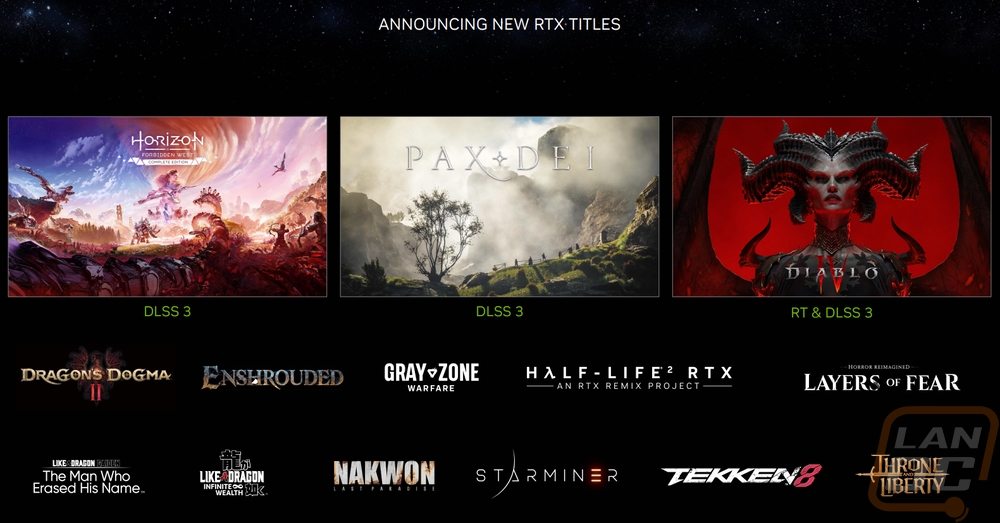
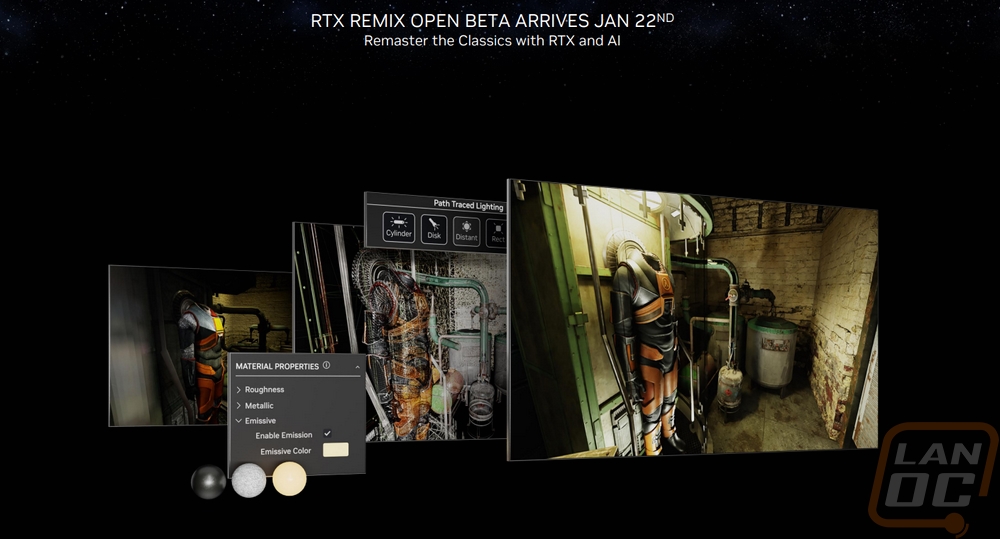
Nvidia and Twitch announced a new way for Twitch streamers to now offer a better range of resolutions. In the past, for anyone who isn’t one of their main partnered streamers you are stuck with just one resolution. This way you will be able to stream at a range of resolutions and frame rates. Viewers who have the bandwidth can enjoy better quality 4k 60 FPS streams but users on mobile or lower-performing internet connections will still be able to watch as well.
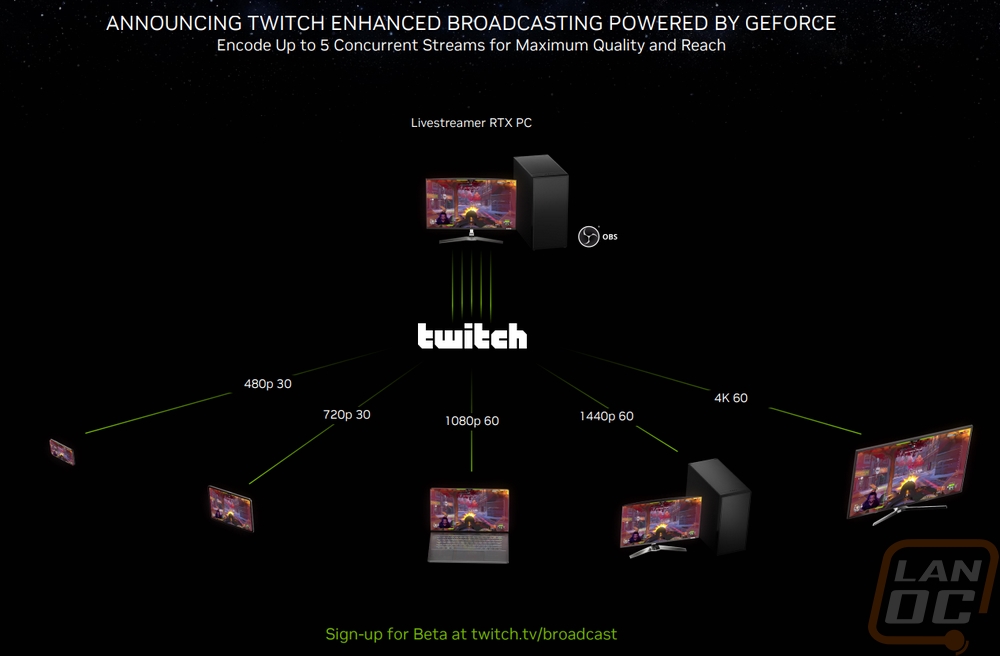
They announced improvements in G-Sync variable refresh rate. Along with that, they covered G-Sync Pulsar which is part of their VRR or variable refresh rate technology. Pulsar bridges the gap between using variable refresh rate and ultra low motion blur to get a smooth experience but cut out the blur that you can get with it.
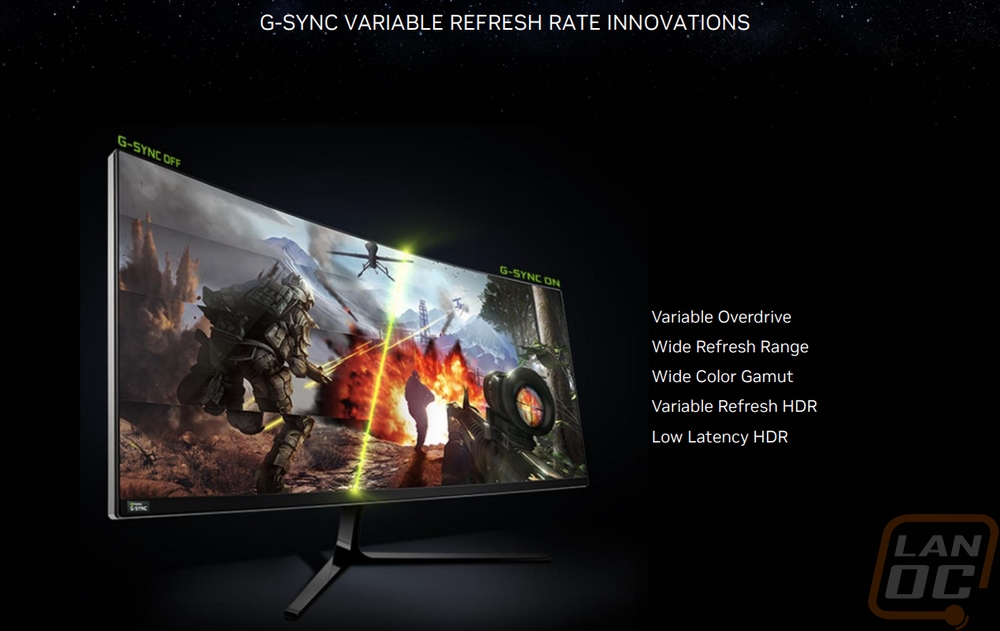

They then of course announced the three new SUPER cards and showed where all three will fit in their updated lineup. The RTX 4080 SUPER will replace the RTX 4080 and sit behind the RTX 4090 still. That will have an MSRP of $999, $200 less than the original MSRP of the RTX 4080. The new card has a faster base clock of 2295 MHz vs 2205 MHz on the 4080 and 40 MHz more on the boost clock with it now at 2550 MHz. The real improvement comes from more cores going from 9728 CUDA cores up to 10240. The RTX 4070 Ti SUPER replaces the RTX 4070 and has an MSRP of $799, the same as the original launch price of the RTX 4070. It gets a memory clock speed improvement but like with the 4080 SUPER, it's big improvements with the CUDA core count jumping up from 7680 up to 8448 which is a big improvement. With all of these cards, the tensor cores and RT cores will also scale up at the same rate as the CUDA cores as well. Lastly the RTX 4070 SUPER doesn’t replace the original RTX 4070, the original is staying in the lineup. The 4070 will now be $549, $50 less than its launch price and the RTX 4070 SUPER takes up that $599 price point and fits in between the 4070 and 4070 Ti SUPER. The CUDA core count goes from 5888 up to 7168, a 21.7% improvement and the same boost and memory clock speeds. Nvidia did bump up the power usage slightly with the 4070 SUPER now having a TGP of 220 Watts to the 200 Watts on the 4070, the 4080 SUPER and 4070 Ti SUPER both stay the same at 285 Watts and 320 watts respectively. Overall though I like that as a refresh the focus is on adding more cores, not cranking up clock speeds which we have seen with things like the RX 480 to RX 580.
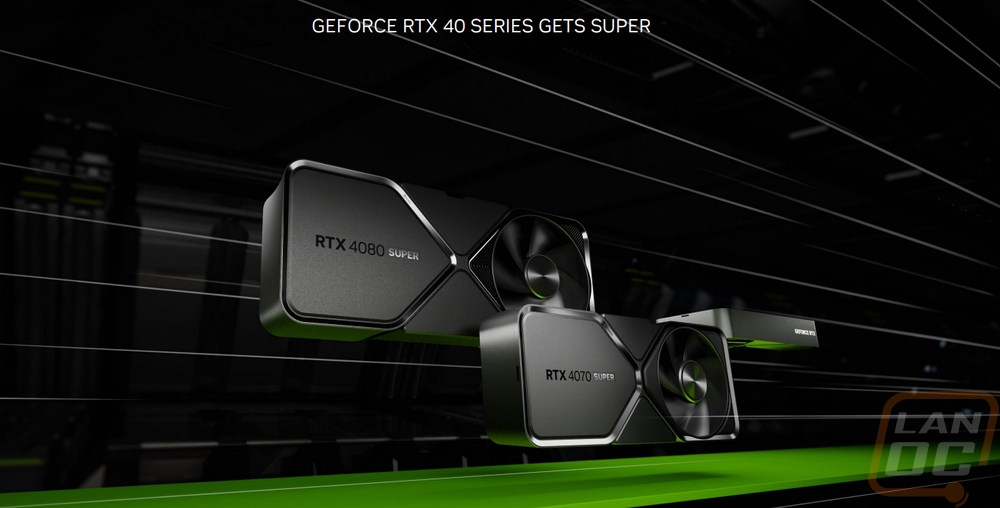
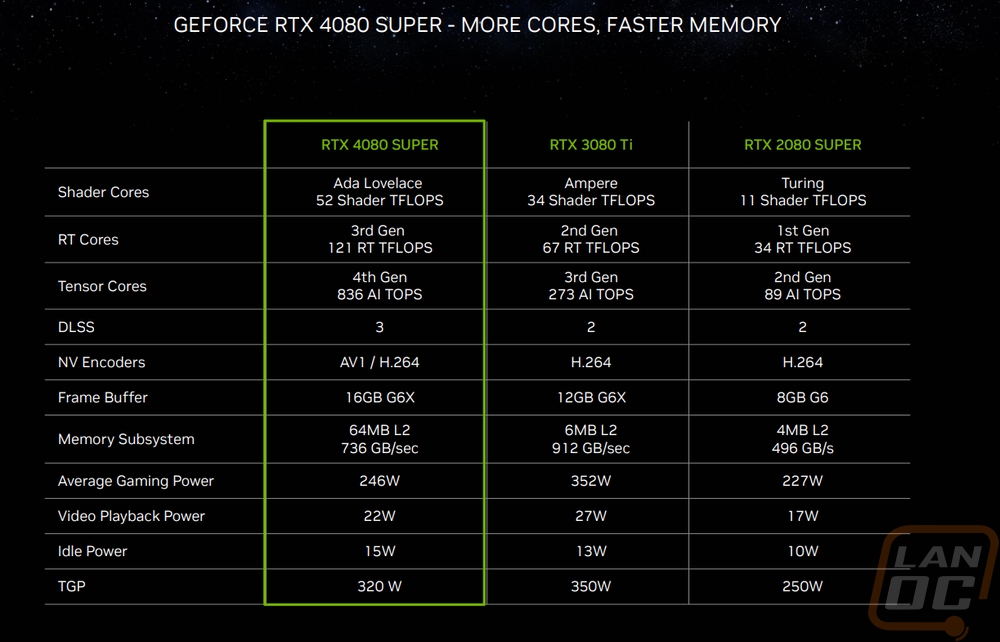
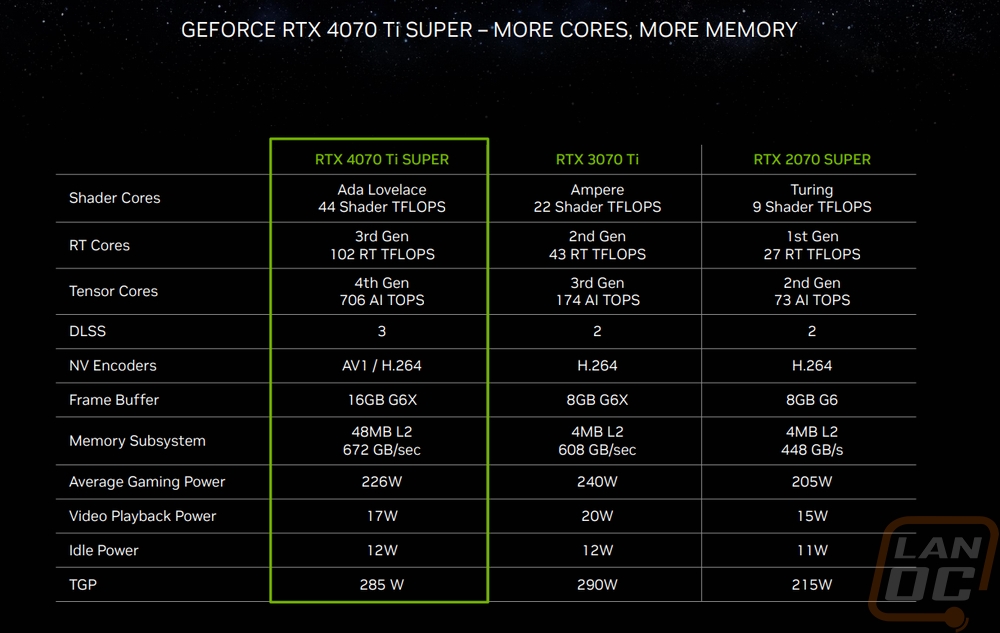
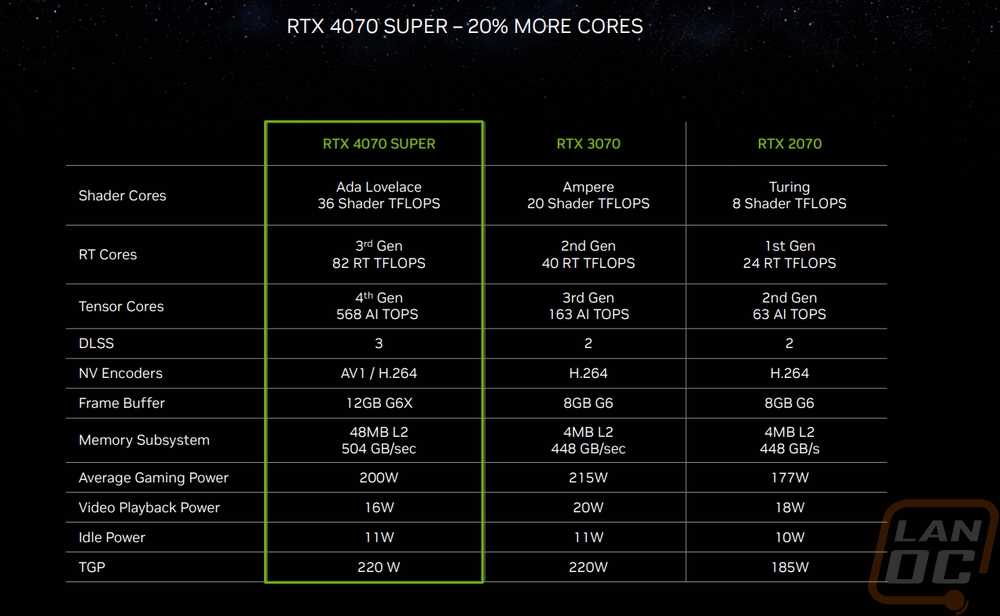

|
Specifications |
RTX 4070 Ti SUPER |
RTX 4080 |
RTX 4080 SUPER |
RTX 4090 |
|
Graphics Processing Clusters |
6 |
7 |
7 |
11 |
|
Texture Processing Clusters |
33 |
38 |
40 |
64 |
|
Streaming Multiprocessors |
66 |
76 |
80 |
128 |
|
CUDA Cores |
8448 |
9728 |
10240 |
16384 |
|
Tensor Cores |
264 (4th Gen) |
304 (4th Gen) |
320 (4th Gen) |
512 (4th Gen) |
|
RT Cores |
66 (3rd Gen) |
76 (3rd Gen) |
80 (3rd Gen) |
128 (3rd Gen) |
|
Texture Units |
264 |
304 |
320 |
512 |
|
ROPs |
96 |
112 |
112 |
176 |
|
Boost Clock |
2610 MHz |
2505 MHz |
2295 MHz |
2520 MHz |
|
Memory Clock |
1313 MHz |
1400 MHz |
1438 MHz |
1313 MHz |
|
Memory Data Rate |
21 Gbps |
22.4 Gbps |
23 Gbps |
21 Gbps |
|
L2 Cache Size |
48 MB |
64 MB |
64 MB |
72 MB |
|
Total Video Memory |
16 GB GDDR6X |
16 GB GDDR6X |
16 GB GDDR6X |
24 GB GDDR6X |
|
Memory Interface |
256-bit |
256-bit |
256-bit |
384-bit |
|
Total Memory Bandwidth |
672 GB/sec |
1008 GB/sec |
736 GB/s |
1008 GB/s |
|
Texture Rate (Bilinear) |
689 GigaTexels/second |
761.5 GigaTexels/second |
816 GigaTexels/second |
1290.2 GigaTexels/second |
|
Fabrication Process |
4N NVIDIA Custom Process |
TSMC 4N NVIDIA Custom Process |
4N NVIDIA Custom Process |
TSMC 4 nm NVIDIA Custom Process |
|
Transistor Count |
45.9 Billion |
45.9 Billion |
45.9 Billion |
76.3 Billion |
|
Connectors |
3 x DisplayPort 1 x HDMI |
3 x DisplayPort 1 x HDMI |
3 x DisplayPort 1 x HDMI |
3 x DisplayPort 1 x HDMI |
|
Power Connectors |
2x PCIe 8-pin cables (adapter in box) OR 300 W or greater PCIe Gen 5 cable |
3x PCIe 8-pin cables (adapter in box) OR 1x 450 W or greater PCIe Gen 5 cable |
3x PCIe 8-pin cables (adapter in box) OR 450 W or greater PCIe Gen 5 cable |
3x PCIe 8-pin cables (adapter in box) OR 450 W or greater PCIe Gen 5 cable |
|
Minimum Power Supply |
700 Watts |
750 Watts |
750 Watts |
850 Watts |
|
Total Graphics Power (TGP) |
285 Watts |
320 Watts |
320 Watts |
450 Watts |
|
Maximum GPU Temperature |
90° C |
90° C |
90° C |
90° C |
|
PCI Express Interface |
Gen 4 |
Gen 4 |
Gen 4 |
Gen 4 |
|
Launch MSRP |
$799 |
$1199 |
$999 |
$1599 |
Before getting into testing I also ran GPUz to double-check that our clock speeds match up with the specifications. In this case, the ROG Strix RTX 4080 SUPER has a listed boost clock in the specifications below of 2640 and we can see that it is running at that. I tested with the same 551.22 driver as I did with the Founders Editon card.

|
ROG Strix RTX 4080 SUPER Specifications |
|
|
Graphic Engine |
NVIDIA® GeForce RTX™ 4080 SUPER |
|
Bus Standard |
PCI Express 4.0 |
|
OpenGL |
OpenGL®4.6 |
|
Video Memory |
16GB GDDR6X |
|
Engine Clock |
OC mode : 2670 MHz Default mode : 2640 MHz (boost) |
|
CUDA Core |
10240 |
|
Memory Speed |
23 Gbps |
|
Memory Interface |
256-bit |
|
Resolution |
Digital Max Resolution 7680 x 4320 |
|
Interface |
Yes x 2 (Native HDMI 2.1a) Yes x 3 (Native DisplayPort 1.4a) HDCP Support Yes (2.3) |
|
Maximum Display Support |
4 |
|
NVlink/ Crossfire Support |
No |
|
Accessories |
1 x Collection Card 1 x Speedsetup Manual 1 x Adapter Cable (1 to 3) 1 x ROG Graphics Card Holder 1 x ROG Velcro Hook & Loop 1 x Thank you Card |
|
Software |
ASUS GPU Tweak III & GeForce Game Ready Driver & Studio Driver: please download all software from the support site. |
|
Dimensions |
357.6 x 149.3 x 70.1mm |
|
Recommended PSU |
850W |
|
Power Connectors |
1 x 16-pin |
|
Slot |
3.5 Slot |
|
AURA SYNC |
ARGB |
Packaging
The packaging for the ROG Strix RTX 4080 SUPER was large like you would expect and because this is Asus’s ROG lineup even on the outside you can pick up on a little extra detail like the ROG Strix Gaming branding having a holo effect on them. The front of the box has the Nvidia green and black wrap-around that takes up a good portion of the packaging. This is consistent with all products other than the Founders Edition cards and it helps make it easy to spot the cards in store all together. That has the RTX 4080 SUPER model name on it and the 16 GB of VRAM mention and Asus slipped in their AURA Sync branding to let us know it has lighting and an OC Edition badge as well. The best part about the front of the box though is that there is a picture of the card taking up most of the box. That includes having the lighting lit up as well and I wish every box had a picture like this right on front. If you shop in store it can be a mess sometimes where you have no idea what you are getting and you spend time looking it all up online. Speaking of pictures, the back of the box has some as well. There are two more pictures of the whole card showing the back and front then they have one showing the heatsink and the power delivery. There is also a basic picture at the bottom along with a line drawing that shows what display connections you get. Most of the pictures also have a description and talk about a few of the features. The only thing missing here really is a specification listing that has the card dimensions and overclock speeds but we never see that.


The outer box comes off and inside you have a black box with some black artwork on it. In addition, the ROG Strix branding is printed here in that same holographic finish. When you open the box up, it flips open and is a lot thicker than you might expect. The top of the box has a thin layer of foam then the bottom has a really thick layer which has the card-shaped cutout. The ROG Strix RTX 4080 SUPER comes sitting in its comfy bed and is inside of a static protective bag. It also comes covered head to toe in plastic protective layers, sometimes two layers thick in some areas. This will take a minute to get all of it pealed up but people who love the peal will be happy. Under the foam tray is another layer with an envelope with the documentation in it and two flip-out sections to the sides of it. Those will have the accessories inside.




One way Asus always stands out with their higher-end products is you don’t just get the card and that is it. With the ROG Strix RTX 4080 SUPER you of course get the 12VHPWR adapter, just like the Founders Edition, with three 8-pin PCIe power connections on one end and the new compact plug on the other end. You get two ROG-branded Velcro wire ties and a wider ROG-branded Velcro strap as well. There is also a small metal GPU support. This is similar to what came with the last TUF card I took a look at only this one has the ROG logo on it. The thumbscrew unscrews and the support extends out and has a rubber bumper on the end.




The documentation envelope was filled up. A lot of that was the cardboard standee that says thank you for your Asus GPU purchase on it. You also get an ROG Strix playing card, they have these for their different product lines and they have a picture of the card as well as stats on them it’s a small thing but a nice token for someone to show off their Asus purchase. Along with those you get a quick start guide and an instruction manual for the included graphics card holder. There is a small booklet for the warranty information as well. Then lastly you get a paper that just touches on how to hook up the 12VHPWR power connection which if you don’t get plugged in firmly can cause a bad connection and some melting, so this is important information to follow.



Card Layout and Photos
With the launch of the RTX 4080 SUPER Asus did of course bring out their new flagship ROG Strix version of the card. If you have seen the Strix RTX 4090 or RTX 4080 from last year the design of this version isn’t any different than before. But beyond seeing pictures I haven’t had either of those cards in hand so I’m excited to get a better look at what Asus has done for their ROG Strix design. Like with the Founders Edition that I already took a look at, the Strix RTX 4080 SUPER has a diecast fan shroud along with a diecast exoskeleton behind it as well. This all-metal design is important for strength, especially as cards have been getting larger, and bending the PCB and microcracks are one of the big reasons for cards to fail later in life. The Strix RTX 4080 SUPER has a triple fan design and for styling they have departed from the complete monochrome design that a lot of components have been going to for a while now. The Strix RTX 4080 SUPER has a textured black finish over a majority of the card but Asus has also utilized a mirrored finish on the front of their Strix branding to contrast that and as you get into the second and third fans they have blue and red fading in as well. I like the monochrome when it comes to being able to match your build, but I have to admit that this looks great and isn’t too bright or flashy so it should still work in most builds. Asus also have a white version of the Strix RTX 4080 SUPER as well which looks even better in my opinion. That version drops the black and red and uses a few light greys for its styling on the bright white.



The Strix RTX 4080 SUPER is a big boy and comes in at an impressive 357.6 mm in length. You can see the ruler that I normally use to measure cards is dwarfed by the card's size and ends near the center of the last fan. It is 149.3 mm tall which puts almost 45 mm of the card up over the top of the PCI bracket. Both of those dimensions you will need to keep in mind when it comes to picking a case for a build using the Strix RTX 4080 SUPER. Most of the newest cases are designed around larger card designs like this but if you have an older case things can get tight quickly even before figuring in the extra height you will need for the power plug up on top, Asus did recess that though so it isn’t as bad as with the Founders Edition. Then for thickness, the card is 70.1 mm thick. That makes it a 3.5-slot card which is especially visible when you see the end view with the PCI bracket looking small compared to the rest of the fan shroud that sticks up on the card width and height. I am surprised that because of that Asus didn’t go with a 3-slot bracket for a little extra strength. My guess is that may be them keeping in mind water cooling support, the Strix cards are one of the best supported when it comes to custom waterblock designs and a thicker bracket would mean even when watercooled the card would still need those three slots.



The fan side of the Strix RTX 4080 SUPER has a die-cast metal shroud around its three fans. I touched on the styling already but you can really see how Asus has used the blue and red to spice things up, who would have thought that with monochrome being the big thing for a while now to match builds better that adding color back in would happen but we see it here and Zotac has done it with their purple holographic touches as well. The three fans have black metal center caps with a machined lip around the outside and each has a holographic variation of the Strix or ROG branding all using the matrix dot layout that Asus uses on some of their motherboards. The three fans are all the same size, with the opening measuring 105mm and 100mm tip to tip. They have seven blades and it is hard to see but the outside does have a ring around it that gives the fans more strength and helps keep the airflow directed down into the heatsink. Speaking of the heatsink we can see the aluminum sheet metal heatsink design which is laid out in a vertical layout which will push the air blow down into it from the axial fans up and out the top and down and out the bottom of the card. This also means there won't be too much airflow going out the ends including the PCI bracket. One thing to note with the fans, Asus has flipped the center fan spinning in the opposite direction. This is something that Gigabyte Windforce has done for a long time and I’m happy to see Asus including it. This means that where the fans are closest to each other they will be going in the same direction which keeps turbulence in that area down. That helps keep the noise down. Asus also has the fans set to turn off with a 0dB technology when the temperatures are below 50c which keeps things silent when you aren’t putting the card under a lot of load. The fan on the far right also is over top of the blow-through section of the heatsink.






Up on the top edge of the Strix RTX 4080 SUPER, a few different things are going on. For starters, this gives us a better look at how the front and back of the card wrap-around with the rounded edges. On the far end of the card, the top does have the full Republic of Gamers brand name spelled out and these are reflective in person but in the picture, they look clear. That is of course all backlit with Aura Sync addressable RGB lighting. Then on the other end, the card also has GeForce RTX printed in white. I wish we could trade both and have the Strix RTX 4080 SUPER model name here, I miss the days where you could show off your high-end card that way as well. The exoskeleton is formed around a small dip switch on the top edge of the PCB and while not visible here the backplate does have a label letting you know that one direction is P Mode and the other is Q mode for performance and quiet modes with it coming in P Mode. Then farther down just before the end of the PCB, the Strix RTX 4080 SUPER has one power connection, the 12VHPWR connection with the clip side of the plug flipped around towards the PCB and the PCB notched around it. Also on the top edge, but also wrapping around on all sides is a lighting accent integrated into the end of the card. This has a clean plastic cover it has small stripe diffusers with gaps of black in between them all around the end of the card.





Working our way around the top and bottom edges as well as the end of the card is normally a great way to get a peak at how the card's cooling is set up. The big 3.5-slot cooler for the Strix RTX 4080 SUPER has both the top and bottom opened up from end to end on 2/3 of each edge. We can see the thick cooler and from the bottom, the exoskeleton blocks the view slightly but you can see the vapor chamber which Asus has milled the heatpipes down into to get more surface area between the two. The seven heatpipes run the length of the card but three of them do have a bend in them at the middle of the card to stagger them on the blow-through end of the card. The end design is interesting, the vertical heatsink layout isn’t pushing air in that direction at all but it does have a vented design with black grills across the end of the card which are all metal as well. The end of the card has a small mounting section on the bottom left corner, this has three threaded holes for supporting the card with a card support. The end also has the ROG branding in silver, but the best feature for sure is the two four-pin PWN fan headers tucked in behind the grill. These add fan headers into your build which is nice, but the main reason for these is so you can have fans being controlled by your GPU temperatures. You can sometimes set that up using software on motherboards but this is an easy plug-and-play way to do it. Most of the time your CPU temperature is what controls all of your fan speeds but what if you are doing something more GPU-focused? You can have the fans that push air near your video card controlled here and fans for your AIO cooling or case overall can then be tied in with your CPU.





The all-metal design of the Strix RTX 4080 SUPER does carry on across the back of the card as well, that shouldn’t be a shock to anyone but it is important to note. The backplate on the Strix RTX 4080 SUPER isn’t just a panel across the back like a lot of aftermarket cards, like the Founders Edition it wraps around at the top and bottom and is fully integrated into the rest of the outside of the card. It has the same textured black finish as well that the front has. But there isn’t a red or blue design on this side. They have the Trix branding machined across the back near the center and a majority of the back also has small groves in it as well which give a little more surface area. The back of the GPU however is cut out around and that is the only exposed part of the PCB on the card. They have printed the GeForce RTX branding in bright white and up under the Strix logo they have coordinates (25°07'29.3"N+121°28'17.3"E ) which are a small easter egg that a lot of the ROG products have that lead back to the Asus building on the outskirts of Taipei. Once you hit the end of the PCB which ends at the power connection the rest of the Strix RTX 4080 SUPER is all blow-through and for that, the backplate has a couple of different openings. There are two triangle-shaped openings and then an irregular pentagon-shaped vent similar to a baseball home base. This has slots machined in it all across it but isn’t just a large opening like most cards have. Some of the grill has a black finish but there is a raised ROG logo also machined into this which gives a nice contrast on the black and puts the logo into 3D space. The back of the Strix RTX 4080 SUPER does also have a sticker towards the PCI bracket with the model and serial numbers along with barcodes. That along with any of the other text is all flipped upside down to make it easier to read when installed in a case as well which is nice.





The PCI bracket end of the Strix RTX 4080 SUPER has a few things going on. For starters, Asus has packed in an extra display connection when compared to most other cards including the Founders Edition. The bottom row of connections has three Display Ports and one HDMI which is what you would expect to see these days. The HDMI is down on the bottom to make it easy to find. But above that they have slipped in a second HDMI above it as well. The bracket does have a section of vents as well but the card isn’t designed to push air in this direction. Each connection is labeled and the PCI bracket itself is also labeled letting us know they used Stainless Steel 304 which is a little stronger to help give the card more strength to its main mounting point. The bracket has a tinted finish, I do still think that a nice black finish would match the card better and look better in a lot of builds.

Of course, I had to get the Strix RTX 4080 SUPER up next to the Nvidia RTX 4080 SUPER Founders Edition. The Founders Edition is big, I know that this picture doesn’t really do it justice, but if you have been out of the game for a few years you would consider it to be a very large card compared to what was the norm just a few generations ago. The Strix RTX 4080 SUPER of course makes that look small though with it sitting taller, longer, and being thicker as well. Asus utilizes their space a little better however by having the power connection down low in the card whereas on the Founders Edition that connection is near the top. I put the two cards on the scale as well. Both have a diecast construction which adds to the weight but the weight also gives us a peak at some of the thermal capabilities as well. The Founders Edition came in at 2125 grams and the Strix RTX 4080 SUPER is 256 grams more at 2381 grams. That puts the Strix RTX 4080 SUPER in at 5.25 pounds for anyone curious.





Before getting into testing I did want to check out the lighting as well. The Strix RTX 4080 SUPER has two areas lit up. Up on the top edge, the Republic of Gamers branding is backlit of course. I’m never big on backlit branding because I don’t want my PC to look like Times Square. But Asus makes up for it with the accent lighting on the Strix RTX 4080 SUPER which is all around the entire end of the card on all four sides. This is unique and nothing like what anyone else is doing and because it goes all the way around the card it will be usable in any orientation. The card looks like it has other areas lit up but that is just the use of a few reflective machined surfaces on the card that helps reflect lighting from other areas. Overall though the Strix RTX 4080 SUPER looks great!




Test Rig and Procedures
Test System
CPU: Intel Core-i9 13900K – Live Pricing
PL1=PL2: 253, τ: 56 / 307A
Motherboard: Asus Z790 Extreme – Live Pricing
Cooling: Corsair H100i Elite LCD Display - Live Pricing
Noctua NT-H1 Thermal Paste - Live Pricing
Memory: Crucial 32GB Kit (2 x 16GB) DDR5-5600 UDIMM– Live Pricing
Storage: Sabrent Rocket Q4 2TB – Live Pricing
Power Supply: be quiet! Dark Power Pro 13 1600W- Live Pricing
Case: Primochill Wetbench - Live Pricing
OS: Windows 11 Pro 64-bit - Live Pricing
|
Our Testing Procedures |
|
|
3DMark |
All 3DMark-based tests are done using the most recent version. We test using all three versions of Fire Strike, Both Time Spy and Time Spy Extreme, and Speed Way. Tests to look at ray tracing performance are done with Port Royal when supported and for Nvidia cards that support DLSS, the DLSS subtest is also done at 1440p with the performance setting and DLSS 2.0 as well as a look at DLSS 1, 2, and 3 at 4K. |
|
Unigine Superposition |
1080p Extreme and 4k Optimized benchmarks along with the VR Future test are done. The VR test is done at the Oculus resolution |
|
VRMark |
Only the Blue room test is run |
|
Far Cry 6 |
Built-in benchmark tested at 1080p, 1440p, and 4k with the Ultra and Medium detail settings |
|
Ghost Recon Breakpoint |
Built-in benchmark tested at 1080p, 1440p, and 4k with the Ultra and Medium detail settings. Texture quality always set to high |
|
Watch Dogs: Legion |
Built-in benchmark testing at ultra and high details. Tested at 1080p, 1440p, and 4k. I also do RTX and DLSS testing on Nvidia cards at 4K using the Ultra detail settings as a base as well. |
|
Borderlands 3 |
Built-in benchmark testing with the ultra detail setting and medium detail setting, done at full screen with default settings at 1080p, 1440p, and 4k on DX11 |
|
Metro Exodus |
Using built-in benchmark, testing at ultra and normal details at 1080p, 1440p, and 4k. I also do RTX and DLSS testing at 4K with the ultra-detail base settings for Nvidia cards as well. |
|
World War Z Aftermath |
Built-in benchmark in DX11 testing both the Ultra detail and Medium detail levels at 1080p, 1440p, and 4K resolutions |
|
The Division 2 |
Built-in benchmark at Ultra detail with V-Sync turned off at 1080p, 1440p, and 4k resolutions. |
|
Total War: Three Kingdoms |
Built-in benchmark using the Battle Benchmark setting. Tested at 1080p, 1440p, and 4k at both high and ultra detail settings |
|
OctaneBench 2020.1 |
OctaneBench is designed to test rendering in OctaneRender. RTX and non-RTX are both ran. This is a CUDA-only test so only Nvidia cards are tested |
|
V-Ray 5 |
V-Ray 5 benchmark us run with CUDA and RTX settings on cards that support it |
|
Boundary Benchmark |
Testing different DLSS detail levels on cards that support it. All testing is done at 4k with RTX on |
|
Bright Memory Infinite RTX Benchmark |
Benchmark all of the different RTX detail levels. Resolution at 4k and DLSS on balanced for each test |
|
Passmark Performance Test 10.2 |
Test using the GPU Compute Score inside of PassMark's Performance Test 10.2 |
|
Blender |
Using the standard Blender Benchmark I run the test using the Blender 3.4 setting which tests using the Monster, Junkshop, and Classroom tests. |
|
Temperature Testing |
Using AIDA64, the GPU stress test is run for 30 minutes or until the result has leveled off. The test is run twice, once with the stock fan profile and a second time with 100% fan speed. During this, I also document the 100% fan speed RPM and document the delta between the fan profile and 100% fan speed as well as get thermal images. |
|
Power Testing |
Using a PCat v2 to monitor power between the PCIe slot and the card as well as power through the power cables I test the peak power when running ADIA64, 3DMark Speed Way, 3DMark Time Spy Extreme, FarCry 6 at 4k and Ultra Detail, Watch Dogs Legion at 4K and Ultra detail, and Blender 3.4.0. The results are then averaged as well as the highest result. |
|
Noise Testing |
Our Noise testing is done using a decibel meter 18 inches away from the video card on the bottom/fan side of the card. We test at 50% and 100% fan speeds as well as a third test while under load using AIDA64's stress test. This is done using a Protmex PT02 Sound Meter that is rated IEC651 type 2 and ANSI S1.4 type 2. Tests are done set weighted to A and set to a slow response using the max function. The ambient noise level in the testing area is 33.3 decibels. |
Synthetic Benchmarks
As always I like to start my testing with a few synthetic benchmarks. 3DMark especially is one of my favorites because it is very optimized in both Nvidia and AMD drivers. It's nice to not have to worry about it being favored too much either way and the repeatability of the results makes it a nice chance to compare from card to card, especially when comparing with the same GPU. For the ROG Strix RTX 4080 SUPER we do have another RTX 4080 SUPER GPU to compare with, the Founders Edition card I just covered. So in addition to keeping an eye on how the ROG Strix RTX 4080 SUPER compares to the RX 7900 XTX and the original RTX 4080 I’m curious to see how it compares to the Founders Edition. The has a boost clock of 2640 MHz whereas the stock clock for the 4080 SUPER is 2520 MHz.
The first round of tests was done in the older Fire Strike benchmark which is a DX11 test. There are three detail levels, performance, extreme, and ultra. The ROG Strix RTX 4080 SUPER came in the base Fire Strike test with a 56042 to the 55495 of the 4080 SUPER Founders Edition, this was an improvement of 1%, not a big jump but often what an overclocked card can get you. In the Fire Strike Extreme test, the ROG Strix RTX 4080 SUPER came in a few points behind the Founders Edition then in Fire Strike Ultra it is was back out in front by a half of a percent.



The next two were both based on the Time Spy benchmark. One is the standard test and then there is the extreme detail level. This test is DX12 based and the Nvidia cards do a little better in general and the ROG Strix RTX 4080 SUPER catches up with the stock-clocked 7900 XTX here and passes it on the Extreme result. In the base Time Spy the ROG Strix RTX 4080 SUPER is out in front of the Founders Edition but with a very small margin but again they trade places for the Time Spy Extreme result.


I did also test using the new 3DMark Speed Way which is their latest benchmark. Speed Way is DX12 as well but combines in more future-focused tech like Ray Tracing which up until now 3DMark has only used in feature tests. Both of the RTX 4080 SUPER are WAY out in front of the 7900 XTX here. The ROG Strix RTX 4080 SUPER however is again sitting behind the Founders Editon on these results even with its overclock.

The last test was using the Unigine-based Superposition benchmark and I tested at 1080p with the extreme detail setting as well as the 4K optimized setting. In the extreme detail setting the ROG Strix RTX 4080 SUPER, the RTX 4080 Founders Edition, and the original RTX 4080 are all clumped together with similar performance on both. The same goes for the 4K result as well.

VR Benchmarks
As for Virtual Reality, I love it but it is more demanding than traditional gaming. This is partially because of the resolutions needed to render for two eyes and because they render more than what is immediately visible. But also because of post effects to get the proper “fisheye” effect for it to look proper in your eyes with the HMD. You also have to have much higher expectations for frame rates in VR, skipping frames or lower FPS can cause motion sickness in VR. Because of that, I ran a few tests.
My first test was again in Superposition. This time I tested the VR Future test using the Oculus resolution. I have also included the average frame rate as well which is important for the cards at the top of the chart because for some reason Superposition is capped at 10,000 for its scores and that doesn’t show the performance gap in those cards at the top. The ROG Strix RTX 4080 SUPER struggled here for some reason coming in behind the original RTX 4080 even with its overclock.

My second round of VR testing was in VRMark which has three tests that are similar to the VR tests in Superposition. I only focused on just the most demanding test called Blue Room which is looking more at future VR performance. The ROG Strix RTX 4080 SUPER didn’t pass the Founders Edition but did still pass the stock-clocked 7900 XTX on this test.

In-Game Benchmarks
Now we finally get into the in game performance and that is the main reason people pick up a new video card. To test things out I ran through our new benchmark suite that tests 8 games at three different resolutions (1080p, 1440p, and 4k). Most of the games tested have been run at the highest detail setting and a mid-range detail setting to get a look at how turning things up hurts performance and to give an idea of if turning detail down from max will be beneficial for frame rates. In total, each video card is tested 45 times and that makes for a huge mess of results when you put them all together. To help with that I like to start with these overall playability graphs that take all of the results and give an easier-to-read result. I have one for each of the three resolutions and each is broken up into four FPS ranges. Under 30 FPS is considered unplayable, over 30 is playable but not ideal, over 60 is the sweet spot, and then over 120 FPS is for high refresh rate monitors.
So how did the ROG Strix RTX 4080 SUPER do? Well, there won’t be anyone surprised that at 1080p the biggest limitation was the CPU. Of the 15 test results 10 of them came in over 120 FPS and the other 5 were over 240 FPS. Turning the resolution up changed things slightly, but still, every result was in that 120+ range with 13 results between 120-239 FPS and two were over 240 FPS. Then at 4K, we can finally see the ROG Strix RTX 4080 SUPER doing work. But even at 4K, every result was in the smooth and playable 60 FPS or higher range with 7 in the 60-119 range and 8 results over 120 FPS. This was a change from the Founders Edition which had 8 in the 60 range and 7 in the 120 range so the overclock on the ROG Strix RTX 4080 SUPER pushed one of the results up into the next category.



Of course, I have all of the actual in game results as well for anyone who wants to sort through the wall of graphs below. I also have averaged out all of the results for the ROG Strix RTX 4080 SUPER, the RTX 4080, RTX 4080 SUPER Founders Edition, and a few other video cards in that range for comparison to get a better idea of how the ROG Strix RTX 4080 SUPER performed and fits with the competition. Honestly with how the ROG Strix RTX 4080 SUPER performed in the synthetic benchmarks I wasn’t sure how it would perform when in game but it did improve on the numbers that the 4080 SUPER Founders Edition did especially at 1080p and 1440p, at 4k the gap is smaller but still there. Comparing things with the RX 7900 XTX the ROG Strix RTX 4080 SUPER way out in front at 1080p and 1440p but the higher VRAM on the XTX helped keep it out in front at 4k with a little less than 4 FPS across the average.
|
Average FPS Across Tested Games |
1080p |
1440p |
4K |
|
ASUS TUF Gaming RTX 4070 Ti SUPER |
213.4 |
183.8 |
114.1 |
|
AMD Radeon RX 7900 XT |
211.1 |
186.6 |
114.8 |
|
Nvidia RTX 4080 FE |
220.7 |
193.5 |
127.5 |
|
Nvidia RTX 4080 SUPER FE |
221.2 |
198.9 |
132.4 |
|
ROG Strix RTX 4080 SUPER |
224.9 |
200.6 |
132.9 |
|
AMD Radeon RX 7900 XTX |
212.9 |
196.7 |
136.7 |
|
Nvidia RTX 4090 FE |
232.7 |
217.3 |
166.0 |
Compute Benchmarks
Now some people don’t need a video card for gaming, they need the processing power for rendering or 2D/3D production, or in some cases, people who game also do work on the side. So it is also important to check out the compute performance on all of the video cards that come in. That includes doing a few different tests. My first test was a simple GPU Compute benchmark using Passmark’s Performance Test 10 and the ROG Strix RTX 4080 SUPER came in right behind the Founders Edition here as well but still well out in front of the original RTX 4080.

Blender is always my favorite compute benchmark because the open-source 3D rendering software is very popular and it isn’t a synthetic benchmark. With the latest version of Blender, they redid the benchmark so we now have a new test that runs three different renderings and gives each a score. I have all three stacked together so we can see the overall performance. The ROG Strix RTX 4080 SUPER did really well here compared to the RTX 4080 SUPER Founders Edition with a big lead on it in both of the combined results.


For CUDA-based cards, I also check out OctaneRender performance using their OctaneBench 2060.1 benchmark which allows me to check out both RTX and non-RTX rendering performance. Here the ROG Strix RTX 4080 SUPER outperformed the Founders Edition by 8 points which comes out to just under 1% on both the total score and total score with RTX. Both were way ahead of the original RTX 4080 and still miles behind the RTX 4090.

For an additional CUDA-based test I also ran V-Ray Benchmark 5 to check out CUDA and RTX performance in the 3D rendering and simulation software. The ROG Strix RTX 4080 SUPER is sitting out in front of the Founders Edition here with a .8% improvement in both results. Both cards are still right up on but still in front of the original RTX 4080 here.

RTX and DLSS
Being an RTX card I also like checking out the performance of some of Nvidia’s features. Namely the ray tracing performance and the performance improvements you can see by using DLSS combined with the tensor cores. My first test goes back to our synthetic benchmarks with 3DMark where I check out their Port Royal benchmark. This is the one test that does also have AMD Ray Tracing support which is great to get a look at how different cards including older non-RTX cards perform. The ROG Strix RTX 4080 SUPER and the 4080 SUPER Founders Edition are right together with nearly the same score here. They have a nice margin in front of the original RTX 4080 but the RTX 4090 is still up in its own class. The RX 7900 XTX on the other hand is a full 3000 points behind them both and running with the 4070 Ti showing that when it comes to ray tracing performance Nvidia is still way out in front.

3DMark also has added in a few feature tests, one being a look at DLSS performance. For this one, I have the resolution set to 4K and I test with all three versions of DLSS as well as with it off completely. All DLSS are set to their performance setting as well to keep the results comparable. This gives us a great look at the performance improvements that DLSS has given with DLSS 3 also including frame generation. The ROG Strix RTX 4080 SUPER started off with DLSS off at 40.47 FPS and using DLSS 1 was an 87% improvement up to 75.78 FPS. DLSS 2 was 157% over the original frame rate to 104 FPS. Then DLSS 3 with frame generation it was a 236% improvement from the original frame rate going up to 136 FPS. Those may sound crazy and they are on the high end but DLSS can mean a huge performance improvement in some situations.

I then jumped into game tests, this time with Watch Dogs: Legion. For this one, I wanted to get an idea of the performance you will see when taking advantage of Nvidia’s RTX and DLSS features. I tested at 4k with the ultra detail setting and with ultra being the setting for DLSS and RTX when they are on as well. I then test with no RTX or DLSS on and then with RTX DLSS on and off and on together. Here the ROG Strix RTX 4080 SUPER shows that in a real game, you can go from 90 FPS down to 48 FPS when you turn on ray tracing. But with DLSS on top of that, you can get the ray tracing experience without losing performance and in this case by gaining 14 FPS. Of course, you can run DLSS without ray tracing as well, and that took the original 90 FPS up to 139 which if you are looking for a smooth frame rate for a high refresh monitor that would make all of the difference.

Cooling Noise and Power
For my last few tests, rather than focusing on in game performance, I like to check out other aspects of video card performance. These are also the most important ways to differentiate the performance between cards that have the same GPU. To start things off I took a look at power usage.
For this, our new test setup utilizes the Nvidia-designed PCat v2 along with cables to handle both traditional 6 or 8-pin connections as well as the new 12VHPWR. The PCat also utilizes a PCIe adapter to measure any power going to the card through the PCIe slot so we can measure the video card wattage exclusively, not the entire system as we have done in the past. I test with a mix of applications to get both in game, synthetic benchmarks, and other workloads like Blender and AIDA64. Then everything is averaged together for our result. I also have the individual results for this specific card and I document the peak wattage result as well which is almost always Time Spy Extreme. The ROG Strix RTX 4080 SUPER surprised me here with its average sitting two watts below the Founders Edition at 324 watts. The peak power draw was also significantly lower at 356 watts, a crazy 37 watts lower than the Founders Edition 4080 SUPER.


With having exact peak wattage numbers when running Time Spy Extreme I was also able to put together a graph showing the total score for each watt that a card draws which gives us an interesting look at overall power efficiency in the popular and demanding benchmark. With the power draw numbers being lower the ROG Strix RTX 4080 SUPER jumped up to the top of the chart in our efficiency charts an impressive 4 points per watt higher than the RTX 4080 SUPER Founders Edition and even up over the RTX 4090.

My next round of tests were looking at noise levels. These are especially important to me because I can’t stand to listen to my PC whirling. Especially when I’m not in game and other applications are using the GPU. For my testing, though I first tested with the fan cranked up to 100% to get an idea of how loud it can get, then again at 50% to get an idea of its range. The ROG Strix RTX 4080 SUPER with its three large fans came in at 39.9 decibels at 50% fan speed which for comparison the Founders Edition came in at 40.8 with a fan less. Cranking the fans up to 100% had the fans running at 3101 RPM which is lower down in our charts. The ROG Strix RTX 4080 SUPER was a little higher in the chart here but still only in the middle of the pack at 59.8 dB .6 dB higher than the Founders Edition.



I also take a look at noise performance while under load. For that when running AIDA64’s stress test I wait until the temperature of the card has leveled off and then measure how loud things are when the card is at its worst-case scenario with the stock fan profile. Here the ROG Strix RTX 4080 SUPER ran extremely quiet at 36.1 dB, a full decible below the Founders Edition which itself ran quiet. While doing this test the ROG Strix RTX 4080 SUPER had its fans running at just 41% when under load which helps keep things quiet.


To finish up my testing I of course had to check out the cooling performance. To do this I ran two different tests. I used AIDA64’s Stress Test run for a half-hour each to warm things up. Then I documented what temperature the GPU leveled out at with the stock fan profile and then again with the fans cranked up to 100%. With the stock profile, the ROG Strix RTX 4080 SUPER leveled out in temps at 61c, this is 1c lower than the RTX 4080 SUPER Founders Edition and puts the monster card down in the bottom portion of our charts. The GPU hotspot was running at 74c, 2c less than the Founders Edition, and 52c for the memory temperature which was 6c less than the Founders Edition.


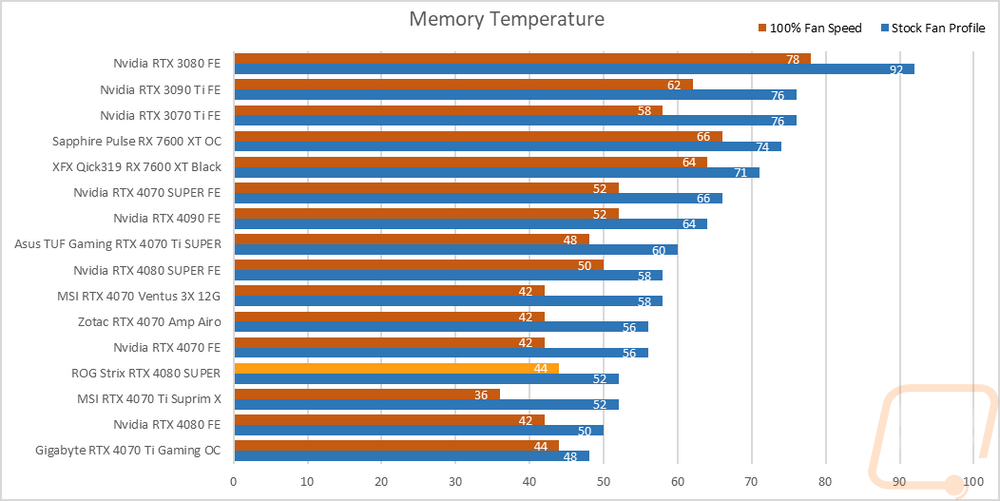
Then with the fans cranked up, the ROG Strix RTX 4080 SUPER dropped down to 54c which is 3c less than the Founders Edition and the delta between that and the stock fan profile was 7c. GPU Hotspot was down to 66c, 4 less than the Founders Edition and the memory was down to 44c, 6c less than the Founders Edition in the same test.
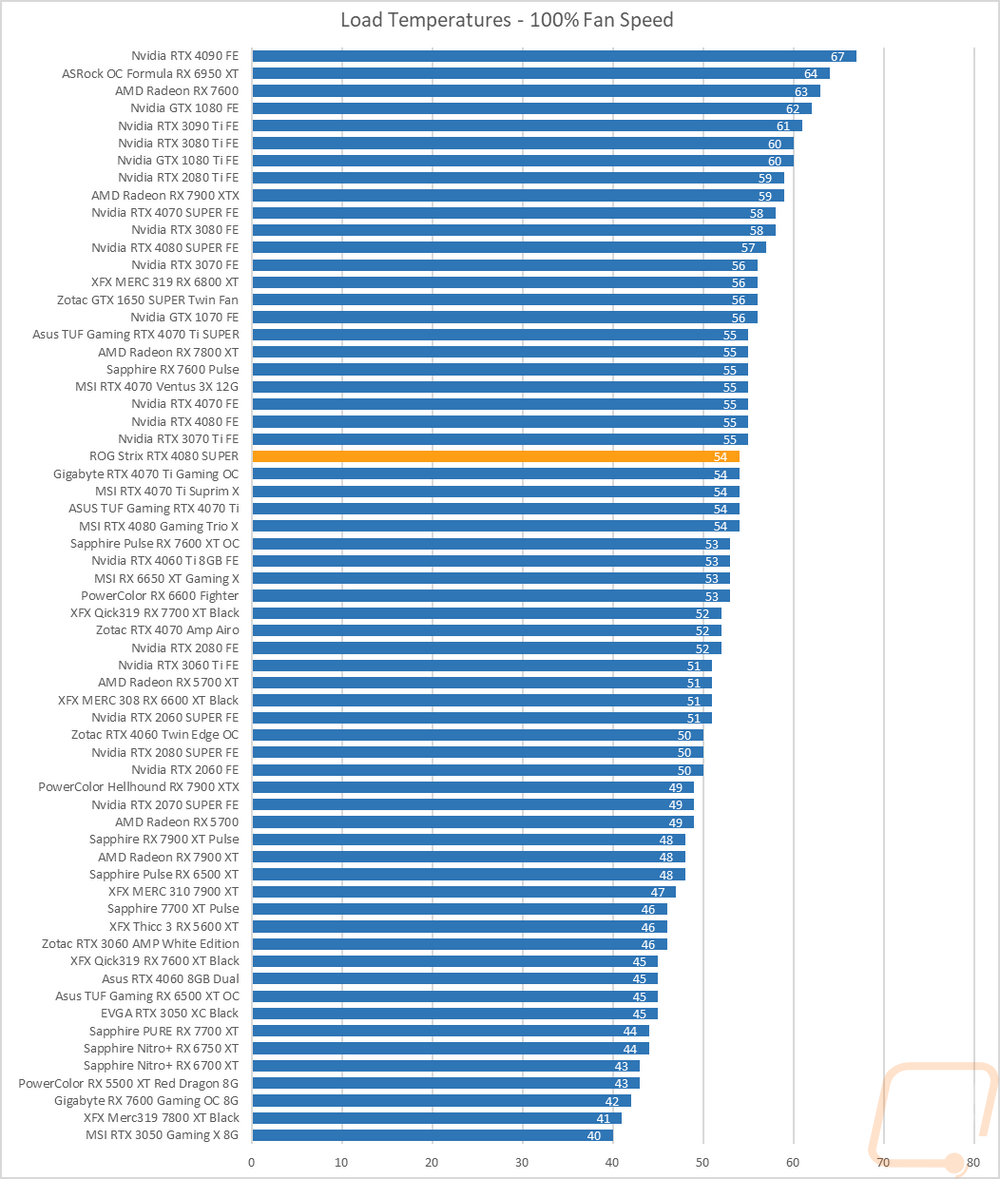
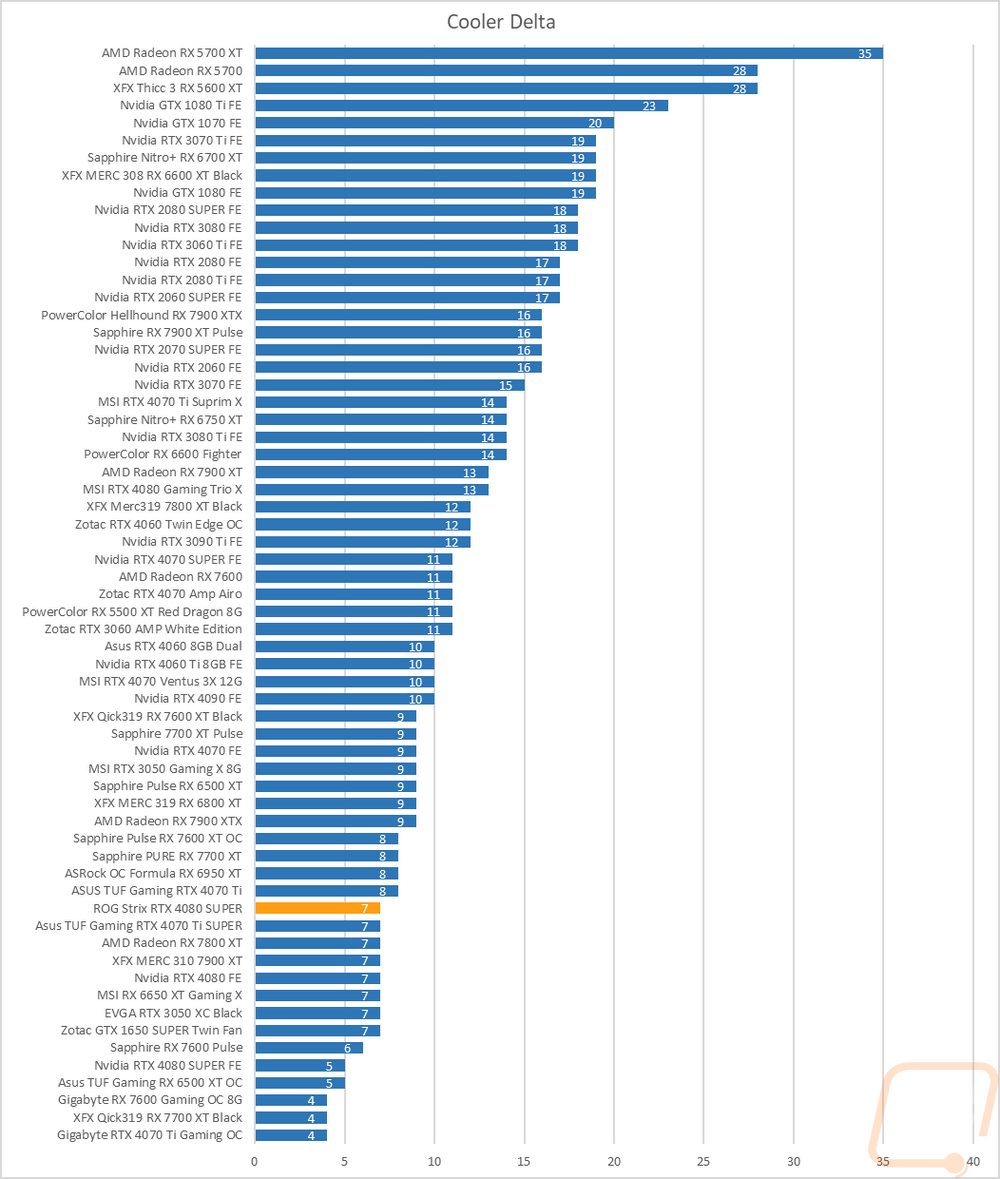
While running the stock fan profile testing I also took the time to get a few thermal images so we could see what is going on. The fan side on the ROG Strix RTX 4080 SUPER is running so cool that it makes the motherboard below it look hot. The warmest spot is in the bottom left but that was just 32.4c and it's nearly room temperature behind the fan on the right end. We can see the heatpipes through the heatsink in this view as well. Up on the top edge is the hottest part of the card, not surprising with this being where a lot of the warmed air vents out. The hotspot here was in the center on the exposed PCB. It is a little cooler to the left and on the right when we get to the blow-through heatsink, it is 20c cooler than on that PCB. Then on the back, the blow-through area is of course running cool at 37.2c. In the middle, the metal backplate is warmed up slightly at 43.6c but the hottest area here is the exposed PCB behind the GPU at 50.8c but that is still running cooler than we saw up on the top edge by 8 degrees.



Overall and Final Verdict
Seeing pictures of the ROG Strix RTX 4080 SUPER just doesn’t do Asus’s new card justice in many different ways. For starters, this card is huge. The Nvidia Founders Edition design for the 4080 SUPER which is the same cooler size used on the 4090 and the 3090 before it is a big card but the ROG Strix RTX 4080 SUPER makes that card look small. There has been a gradual creep up in card size and with this being the flagship card, it shows it the most. Beyond that though the pictures don’t give you any idea of the build quality of the ROG Strix RTX 4080 SUPER as well. The textured black fan shroud looks great with its use of the reflective Strix logo and the blue and red additions, but in a photo, you might think it is your standard black plastic fan shroud. The entire shroud and backplate are diecast. Asus also has an exoskeleton under the shroud that is also diecast as well for additional strength. That strength is important given the card's weight and what can happen over time with sagging and PCBs bending. Asus also goes above that with a thick PCB and gluing the GPU in addition to soldering. The design also adds in small details like the fan headers at the end of the card, these make it plug-and-play to have a few case fans that speed up depending on your GPU temperatures rather than your CPU like your motherboard connections will do without changing the settings.
With the large cooler design, the ROG Strix RTX 4080 SUPER did of course perform really well in our cooling performance benchmarks. It ran cooler than the Founders Edition card in all of our tests, especially when we dive into the GPU hotspot and memory temperatures where it stands out. Its noise performance was even better when under load, the only time it was noisier was when you have the three huge fans cranked up to 100% fan speed which it was never close to needing. It was also surprisingly power efficient, with its peak power draw and power draw in our 3Dmark Time Spy Extreme test being significantly lower than the 4080 SUPER Founders Edition putting the ROG Strix RTX 4080 SUPER at the top of our chart in power efficiency with it being better than the 4090 in that test. The only downside in my testing was that with that power efficiency, the ROG Strix RTX 4080 SUPER didn’t really set itself apart from the Founders Edition in a lot of our performance testing. At stock settings, you do get a few FPS more in games, but it seems that Asus has left a lot of the potential performance on the table for you to get with overclocking. The cooler is capable of handling anything you throw at it, we know that. Thankfully getting more out of the card can be as simple as one adjustment in Asus’s GPU Tweak III software. Here are the numbers comparing the Strix RTX 4080 SUPER to the Founders Edition when you run stock and max power targets. The big thing here is that the Strix has a higher limit on its power target, so where the Founders Edition can run at up to 110% the Strix can go up to 131%. This is a huge performance jump between the two with the Founders Editon reaching 14466 and the Strix at almost 1000 higher on its score of 15426.
|
|
Time Spy Extreme GPU Score |
Power Target % |
|
Stock Power Target |
||
|
Nvidia RTX 4080 SUPER Founders Edition |
14293 |
100% |
|
ROG Strix RTX 4080 SUPER |
14254 |
100% |
|
Max Power Target |
||
|
Nvidia RTX 4080 SUPER Founders Edition |
14466 |
110% |
|
ROG Strix RTX 4080 SUPER |
15426 |
131% |
Like with the Founders Edition review, the Strix RTX 4080 SUPER does extremely well at 4k, handling anything I threw at it in our testing. It also stands out ahead of the competition from AMD when it comes to ray tracing performance and DLSS 3 is still the way to go as well. I said it in my original review but the RTX 4080 SUPER is the GPU that the original RTX 4080 should have been both in performance and pricing and that stands here as well. The Strix RTX 4080 SUPER has an MSRP of $1249.99 (assuming you can find one at that price), the original Strix RTX 4080 when it launched was $1550 so Nvidia’s price drop has helped bring this card down some as well. But you are still paying a big margin over the base RTX 4080 SUPER MSRP. Is it worth that premium? That is really going to depend on what you are looking for in your card. A lot of people will say you are paying an ROG tax but the reality is that you are paying for the high-end diecast shroud, backplate, and exoskeleton, top of the line components, and a huge air cooler. If you want the best possible performance but aren’t looking to throw down for an RTX 4090 then this is the way to go. Unlike with some of the other GPUs though, the price gap between the RTX 4080 SUPER and the RTX 4090 is the one area where these higher-end cards can still be a good option. But if you would be happy with the base RTX 4080 SUPER performance then there are going to be cheaper options including other options from Asus. That is why Asus and their competitors have a range of cards.


Live Pricing: HERE




